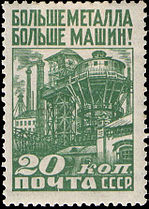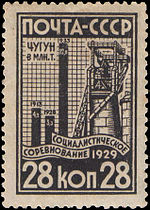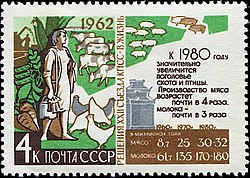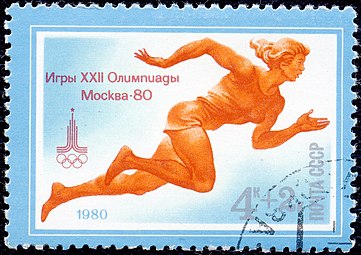Postage stamps of the Soviet Union
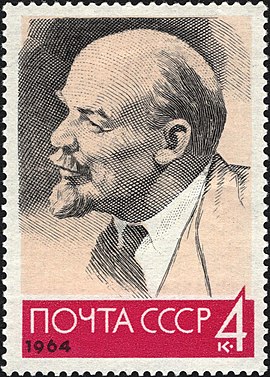
Stamps of the Soviet Union were issued in the period 1923 to 1991. They were labeled with the inscription Russian: "Почта СССР" ("Post of the USSR"). In the thematics, Soviet stamps reflected to a large extent the history, politics, economics and culture of this world's first socialist state.[1]
Notable designers of Soviet postage stamps were Ivan Dubasov (who designed the Lenin Mourning issue, the first stamps portraying Vladimir Lenin in 1924) and Vasily Zavyalov. By the mid-1970s, over 4,000 stamps came out in the USSR. In 1970, the Catalogue of Postage Stamps of the USSR, 1918–1969 was published in Moscow, the yearly supplements being produced afterwards. The history and design of Soviet postage stamps were elucidated in the annual publication Soviet Collector and the monthly magazine Filateliya SSSR.[1]
First stamps
[edit]The first postage stamps of the newly proclaimed Union of Soviet Socialist Republics were designed by Georgy Pashkov and issued in August 1923 in relation to the First All-Russian Agricultural and Handicraft Exhibition.[2]
- First All-Russia Agricultural Exhibition issue of 1923
-
Reaper, 1 rouble
-
Sower, 2 roubles
-
Tractor, 5 roubles
-
Exhibition general view,
7 roubles
Definitive issues
[edit]
The first series of the USSR definitive stamps known as the Gold Standard issue appeared in October 1923. Their design proposed by Ivan Shadr included the busts of the worker, Red Army soldier and peasant.[3][2] Also, there was a plan to sell more stamps in the international market. By targeting stamps for sales abroad, the Soviet government reckoned on earning hard currency.[3]
- Examples of 1929 stamps with face values of 7 and 14 kopecks
-
Worker, soldier and peasant,
3rd definitive issue, 1929 -
Lenin, 3rd definitive issue, 1929
-
1st All-Union Pioneer Rally, 1929
Over the years, there was a steady increase in the number of different stamps issued annually by the USSR.[3] Stamp denominations continued including international postage rates. For instance, most new issues during 1939 and 1940 had face values between 10 and 30 kopecks, i.e. more than those for standard internal postage.[3]
- Examples of 1939 stamps with face values of 10 and 30 kopecks
-
Gorky Street, Moscow
-
Lenin Library, Moscow
-
USSR Pavilion at the
1939 New York World's Fair -
Factory woman, 5th definitive issue
-
125th birth anniversary
of Taras Shevchenko -
Dairy farming, milkmaid with prize cow, All-Union Agricultural Exhibition
-
Emblem "Tractor Driver and Kolkhoz Woman", All-Union Agricultural Exhibition
-
Central Pavilion, All-Union Agricultural Exhibition
-
Glider, Soviet Aviation Day
-
Parachutists, Soviet Aviation Day
-
Airman, 6th definitive issue
-
50th death anniversary
of Mikhail Saltykov-Shchedrin -
Sochi, Caucasian health resorts
-
125th birth anniversary
of Mikhail Lermontov -
50th death anniversary
of Nikolay Chernyshevsky
- Examples of 1940 stamps with face values of 10 and 30 kopecks
-
80th birth anniversary
of Anton Chekhov -
10th death anniversary
of Vladimir Mayakovsky -
20th anniversary of the
Perekop operation
One of the important topics represented on the USSR stamps was the Communist Party of the Soviet Union. It was usually done in two ways:[3]
- dedicating stamps to numerous remarkable Party members, both the living and the deceased,
- placing the Party slogans and resolutions.
-
Stalin souvenir sheet of 1949 celebrating the 70th birth anniversary of Joseph Stalin
-
Be a Hero!, the first USSR stamp dedicated to the Great Patriotic War, 1941
-
"Long live the victory of the Anglo-Soviet-American fighting alliance! (Stalin)", a 1943 stamp marking the Tehran Conference
Vladimir Lenin was pictured on Soviet stamps most often among the Bolsheviks, with the first Leniniana stamps appeared after his death in January 1924. Lifetime images of Party members on stamps were used to emphasize the theme of state power. One of such examples was a 1935 set of stamps commemorating Mikhail Kalinin's 60th birthday and depicting him as a worker, a farmer, and an orator. These Kalinin stamps illustrated the motive powers of the Soviet state: the worker, the farmer, and the Communist Party. Such a practice is considered a worldwide trend when in-power politicians are shown on postage stamps symbolizing the state.[3][4]
The Party slogans and resolutions on Soviet stamps changed over time. Earlier stamp themes in the 1920s reflected, though indirectly, the spirit of New Economic Policy. Since 1929, stamps had been used for a clear declaration of the changed economic policies. When Joseph Stalin initiated industrialisation, a special set of stamps was issued to support this effort. For example, the 10-kopecks stamp showed a series of tractors, saying "Let us increase the harvest by 35%". An inscription on the 20-kopecks stamp called for "More metal, more machines!". The 28-kopecks stamp pictured a blast furnace, a chart for iron-ore production and the slogan "Iron, 8 million tons".[3][5]
- Slogans of the Industrialisation issue, 1929
-
"For the lower cost of goods sold, for work discipline, for the better quality of a product"
-
"Let us increase the harvest by 35%"
-
"More metal, more machines!"
-
"Iron, 8 million tons"
After the Great Patriotic War, the government used stamps to call for economic reconstruction and mobilisation. A 1946 stamp issue summoned: "Give the country annually 127 million tons of grain", "60 million tons of oil", "60 million tons of steel", "500 million tons of coal", and "50 million tons of cast iron".[3][6]
-
"Give the country annually 127 million tons of grain", 1946
-
"By 1980 livestock, cattle and chickens will be significantly increased. Production of meat will grow almost 4 times,
milk almost 3 times", 1962
Short heroic slogans of the Stalin period calling for economic mobilization were substituted on Soviet stamps in the post-Stalin years. Party platforms with rather lengthy excerpts from Party documents and congresses' resolutions appeared on stamps at that time. Such was, for instance, the series of "Decisions of the 22nd Congress of the Communist Party of the Soviet Union—into Life" that was designed by Vasily Zavyalov and A. Shmidshtein, and issued in 1962.[3][7]
In later years, the style of stamp messages continued, differing from those of the Stalin times. They were no longer brief imperative commands but rather promises and explanations by the Party to Soviet society. For example, on a 1971 souvenir sheet from the 24th Party Congress series designed by Yu. Levinovsky and A. Shmidshtein, there was an inscription saying that "the main problem is to provide a significant increase of the material and cultural level of life of the people on the basis of high rates of development of socialist production, an increase of its effectiveness, scientific-technical progress, and an acceleration of the growth of the productiveness of labor".[3][8][note 1]
Such messages were typical of stamps for the Brezhnev and post-Brezhnev period until the changes occurred under Mikhail Gorbachev.[3] New slogans, "perestroika", "uskoreniye", "demokratizatsiya", and "glasnost", were coined and appeared on the postage stamps of the USSR.

|

|

|
- Soviet Union was a sport powerhouse
-
1988 World Allround Speed Skating Championships for Men in Alma-Ata (now "Almaty")
Rarities
[edit]

A unique complete pane of 25 early Soviet Union stamps is known as Soviet Air Post "Wide 5" surcharged. The stamp itself was produced in 1924 as a surcharge of 10 kopecks on 5-rouble green type II, basic stamp wide "5".[9][10]
In 1925, a 15-kopeck yellow stamp of "Peasant" design was printed in a very small quantity within the Gold Standard issue. Named Limonka, it is considered very rare, especially if in mint condition.[11]
-
Limonka, 1925,
15 kopecks -
Aspidka, 1931, 50 kopecks, perforated
Another very rare Soviet stamp, issued in 1931, is Aspidka, especially if imperforate; 24 imperforate specimens are known. Its design was created by Vasily Zavyalov.[12]
In 1932, the All-Soviet Philatelic Exhibition was organized in Moscow. On that occasion, a souvenir sheet of four stamps known as Personalised Kartonka was produced on thick card, with three-line overprint "To the best shock worker of the All Russian Philatelic Society – President of the Moscow Philatelic Organization E.M. Nurk". It is considered rare because only 25 souvenir sheets were issued.[13][14]
A San Francisco inverted surcharge with small Cyrillic "ф" ("f") is characteristic of a rare Soviet stamp called Levanevsky with overprint. Possibly unique, it was designed by Vasily Zavyalov and issued in 1935.[15]
-
Levanevsky with overprint, 1935, 1 rouble on 10 kopecks
-
Green souvenir sheet, 1964, 1 rouble
-
Russian Tokyo 1964. Trial edition - Goznak factory
-
tokyo olympiad 1964 attempt to colour red embossed sign goznak
Due to a plate error (asymmetric star), a variety of the first Soviet numbered Tokyo Olympic souvenir sheet of 1964 is now quite rare and known as Green souvenir sheet.[16] The Russian Goznak stamp factory has released several sheets of the Tokyo 1964 trial stamps, they are very rare and there are few left.[citation needed]
Stamp thematics and other aspects
[edit]

The 24th Communist Party of the Soviet Union Congress resolutions. Miniature sheet of 1971
Soviet Union stamps covered a great variety of themes. The thematics mirrored various aspects of Soviet history, politics, economics, and culture. These included:
- the accomplishments of the Great October Socialist Revolution,
- achievements of industry, agriculture, science, and culture,
- various anniversary celebrations.[1]
After 1929, the quality of the Soviet stamps improved. Their agitational content expanded, as well. Increasing attention was given to stamps with face values of 7, 14, and 28 kopecks used for international correspondence.[3] These stamps were "supposed to tell the truth to the world about the victories of the workers' country of the Soviets".[17]
See also
[edit]- 70r Red Army Soldier error
- Definitive stamps of the Soviet Union
- First USSR stamps
- Gold Standard issue
- International trading tax stamp
- Leniniana
- List of paintings on Soviet postage stamps
- List of postage stamps
- Postage stamps and postal history of Russia
- Soviet and post-Soviet postage rates
- Soviet space exploration history on Soviet stamps
- Soviet Union stamp catalogue
Notes
[edit]References
[edit]- ^ a b c Владинец, Н. И. [Vladinets, N. I.] (1975). "Почтовые марки" [Postage stamp]. In Прохоров, А. М., гл. ред. (ed.). Большая советская энциклопедия: в 30 т. (1970–1979) [The Great Soviet Encyclopedia] (in Russian and English). Vol. 20 (Плата – Проб) (3rd ed.). Moscow: Советская энциклопедия [Soviet Encyclopedia]. Retrieved 21 June 2015.
{{cite book}}: CS1 maint: multiple names: authors list (link) - ^ a b c d e f g h i j k l m Grant, J. (July 1995). "The socialist construction of philately in the early Soviet era". Comparative Studies in Society and History. 37 (3): 476–493. doi:10.1017/S0010417500019770. ISSN 0010-4175. JSTOR 179216. S2CID 143458562. Archived from the original on 25 December 2016
- ^ "Stamps of the USSR (1923–1991): 1935. November. To the 60 anniversary from the date of M. I. Kalinin's birth". Philately: Catalog. Post stamps. Russian Empire. USSR. Scandinavian Catalog; skandinav.eu. Archived from the original on 26 June 2015. Retrieved 25 June 2015.
- ^ "Stamps of the USSR (1923–1991): 1929. November. For industrialization of the USSR". Philately: Catalog. Post stamps. Russian Empire. USSR. Scandinavian Catalog; skandinav.eu. Archived from the original on 26 June 2015. Retrieved 25 June 2015.
- ^ "Stamps of the USSR (1923–1991): 1946. October. Post-war restoration and development of a national economy". Philately: Catalog. Post stamps. Russian Empire. USSR. Scandinavian Catalog; skandinav.eu. Archived from the original on 26 August 2015. Retrieved 25 June 2015.
- ^ "Stamps of the USSR (1923–1991): 1962. November – December. Solutions of XXII Congress of CPSU – in life!". Philately: Catalog. Post stamps. Russian Empire. USSR. Scandinavian Catalog; skandinav.eu. Archived from the original on 26 June 2015. Retrieved 25 June 2015.
- ^ "Stamps of the USSR (1923–1991): 1971. September 29 – December 15. Solutions XXIV of Congress of CPSU – in life!". Philately: Catalog. Post stamps. Russian Empire. USSR. Scandinavian Catalog; skandinav.eu. Archived from the original on 26 June 2015. Retrieved 25 June 2015.
- ^ "Stamps of the USSR (1923–1991): 1924. May. Air mail". Philately: Catalog. Post stamps. Russian Empire. USSR. Scandinavian Catalog; skandinav.eu. Archived from the original on 26 June 2015. Retrieved 25 June 2015.
- ^ "Lot No. 5005". Past auctions and realizations: Russia Air Post. New York: Cherrystone Auctions. June 2008. Archived from the original on 26 June 2015. Retrieved 25 June 2015.
- ^ "Stamps of the USSR (1923–1991): 1925. January – 1927. March. The first standard issue". Philately: Catalog. Post stamps. Russian Empire. USSR. Scandinavian Catalog; skandinav.eu. Archived from the original on 26 June 2015. Retrieved 25 June 2015.
- ^ "Stamps of the USSR (1923–1991): 1931. May. Building of dirigible balloons in the USSR". Philately: Catalog. Post stamps. Russian Empire. USSR. Scandinavian Catalog; skandinav.eu. Archived from the original on 26 June 2015. Retrieved 25 June 2015.
- ^ "Stamps of the USSR (1923–1991): 1932. December. 1st All-Union Philatelic Exhibition in Moscow". Philately: Catalog. Post stamps. Russian Empire. USSR. Scandinavian Catalog; skandinav.eu. Archived from the original on 26 June 2015. Retrieved 25 June 2015.
- ^ "Lot No. 348". Past auctions and realizations: Soviet Union 1932 – the unique souvenir sheet of four. New York: Cherrystone Auctions. October 2008. Archived from the original on 26 June 2015. Retrieved 25 June 2015.
- ^ "Stamps of the USSR (1923–1991): 1935. August. Air mail. Flight. Moscow. The North Pole. The United States of America". Philately: Catalog. Post stamps. Russian Empire. USSR. Scandinavian Catalog; skandinav.eu. Archived from the original on 26 June 2015. Retrieved 25 June 2015.
- ^ "Stamps of the USSR (1923–1991): 1964. July – September. The XIII Olympic Games in Tokyo". Philately: Catalog. Post stamps. Russian Empire. USSR. Scandinavian Catalog; skandinav.eu. Archived from the original on 26 June 2015. Retrieved 25 June 2015.
- ^ Бухаров, О.Н. [Bukharov, O. N.] (1982). Marki – svideteli istorii [Stamps As Witnesses of History] (in Russian). Moskva [Moscow]: Радио и связь [Izdatel'stvo Radio i Sviaz']. p. 37.
{{cite book}}: CS1 maint: multiple names: authors list (link)
External links
[edit] Media related to Stamps of the Soviet Union at Wikimedia Commons
Media related to Stamps of the Soviet Union at Wikimedia Commons

































